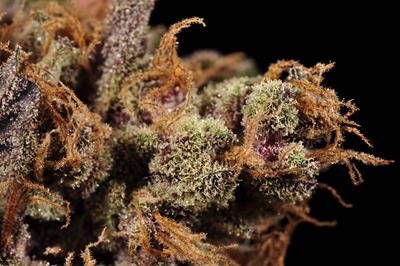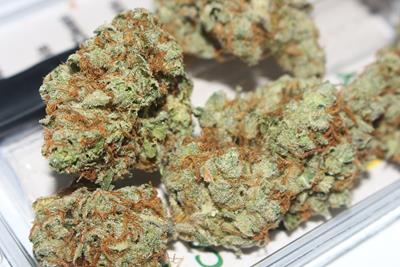
Thursday May 25, 2017
 Health/Science
Health/Science
There is a lot more that goes into the therapeutic potential of cannabis than cannabinoid profiles. Though cannabinoids themselves offer a plethora of therapeutic value, it is actually the terpenes, or aromatic oils found in the plant, that make the effects of various cannabis strains differ as much as they do. If you’ve ever wondered why sativa strain X affects you differently than sativa strain Y does, this is it.
What are Terpenes
Terpenes are naturally occurring aromatic oils that produce different sensations and effects on the body. By simply smelling these “terps,” you might find your mood lifted, your anxiety reduced or your body relaxed (depending, of course, on which terpenes you are smelling at the time). Like cannabinoids, they interact with cannabinoid receptors within the body to exert different physiological effects and mediate cannabinoid interactions.
Terpenes are not exclusive to cannabis either. In fact, they can be found in a number of plants including fruits, flowering plants and grains. For example, myrcene, a terpene with a musky scent that has been shown to increase permeability between the blood/brain barrier, can be found in cannabis, beer and mangos.
This is one reason that consuming beer or mangos prior to ingesting cannabis can increase your high – more THC is able to break through the blood/brain barrier by hopping a ride on the back of myrcene terpenes.
Terpenes live in sticky resin glands of plants. In the case of cannabis, they are located in the same mushroom-shaped trichomes that cannabinoids can be found in – adding to the potency of concentrated forms of cannabis. Because they are so pungent, terpenes are often one of the first characteristics noticed by consumers, and strain names are often chosen based on these characteristics as well. This, of course, makes it much easier to choose the best strain for both flavor preference and aromatic therapy.
How Different Terpenes Affect the Mind and Body
Though the evolutionary purpose of terpenes is to deter pests, attract pollinators and protect organisms from harmful bacteria and fungi, their therapeutic value far exceeds this. Pre-dating Christianity by as much as 10,000 years, our ancestors are thought to have burned aromatic wood, flowers and herbs to drive out “evil spirits” from the mentally-ill. Aromatic perfumes were also used in religious ceremonies, medical practices and the embalming of the deceased. Though little was known about the exact benefits of these aromatic oils then, our knowledge of essential oils and the terpenes within them has grown extensively over the last decade. We now not only know which terpenes are the most powerful, but what kind of therapeutic value they each have, as well. Here are some of the most popular terpenes found in cannabis along with their therapeutic potential.
 Terpenes provide a plethora of beneficial effects. click to enlarge
Terpenes provide a plethora of beneficial effects. click to enlargeTypes of Terpenes
Linalool
Linalool features a distinct floral scent (like lavender) and has been shown to reduce anxiety and promote restful sleep. Studies also suggest that linalool can boost immune system functioning, reduce inflammation and, in turn, improve cognitive and emotional processes by reducing swelling in the brain. Linalool has also been approved by the FDA as an effective pesticide which means that strains like LA Confidential, Lavender Haze and Grand Daddy Purps could be great companion plants in your next garden, too!
Myrcene
Myrcene is the most common terpene found in cannabis, distinguishable by its earthy, musky flavor. It is especially common in indica strains and, in high doses, can produce quite the “couch lock” effect. Myrcene is also unique in that it improves penetration through the blood/brain barrier allowing cannabinoids like THC to take effect more quickly. Jack Flash, Mango Star and White Widow are great, myrcene-rich strains.
Pinene
As its name suggests, pinene terpenes feature the distinct flavor or pine or evergreen trees. Thought to lessen the intensity of THC, pinene terps act as an anti-inflammatory, a bronchodilator (opens the airways) and an antiseptic. Pinene terpenes also have anti-tumor properties and has been used as such in Traditional Chinese Medicine for centuries. Strains high in pinene terpenes include Headband, Master Kush and AC/DC.
Limonene
As one of two compounds derived from pinene, limonene has been shown to elevate mood and promote weight-loss. It features a distinct citrus flavor like lemon or orange with a sometimes herbal undertone similar to juniper, rosemary or peppermint. Limonene is commonly used in the preparation of foods and perfumes, and can be used as a pest deterrent, as well. You’ll find limonene terpenes in strains like Super Lemon Haze, Agent Orange and Durban Poison.
Caryophyllene
This spicy, woody, peppery terpene has been shown to readily interact with the endocannabinoid system and has shown great promise as a cancer treatment as it protects against nephrotoxicity (toxicity in the kidneys) as a result of chemotherapy. It is also effective as an analgesic and anti-inflammatory and also works to counteract some of the adverse effects of THC. The flavor is reminiscent of foods spices like cinnamon, basil, cloves or black pepper and can be found in strains like Bubba Kush and Skywalker OG.
Terpinolene
Terpinolene features a smoky, woody odor that can be found in many flowering plants including apple, tea tree, lilac and cumin. Though it is not an anti-inflammatory or analgesic like most other terpenes found in cannabis, it does possess anti-cancer properties in addition to anti-fungal and anti-bacterial properties. It is also a mild sedative making this terpene ideal for promoting sleep and reducing anxiety. Strains high in terpinolene include Afghani, Pineapple Hashwreck, and Sour Diesel.
Cannabis has huge therapeutic potential, and not just because of those exciting cannabinoids – trichomes play a major role, too. Trichomes not only add flavor to buds, they influence the therapeutic value by acting on CB receptors to mediate the effect of cannabinoids. They can pick you up, put you down and much more, and they taste good, too!
What terpenes do you prefer in your cannabis? Do you have a favorite strain that features it? We’d love to hear about it.







